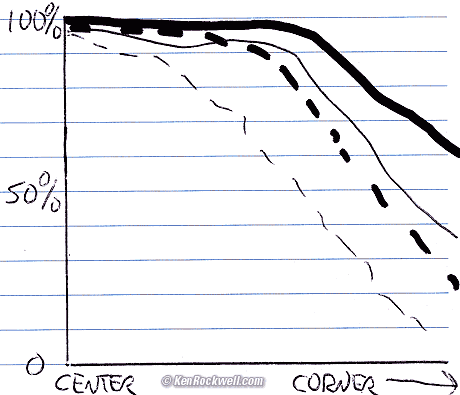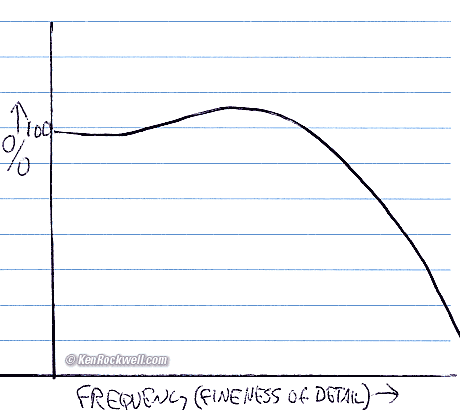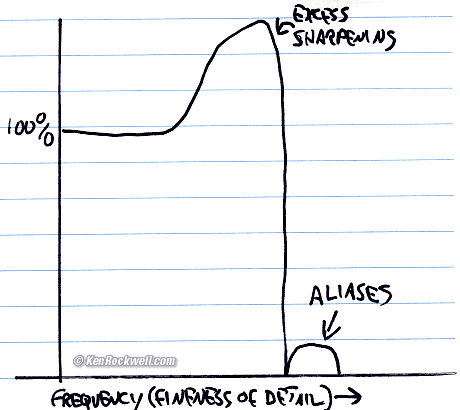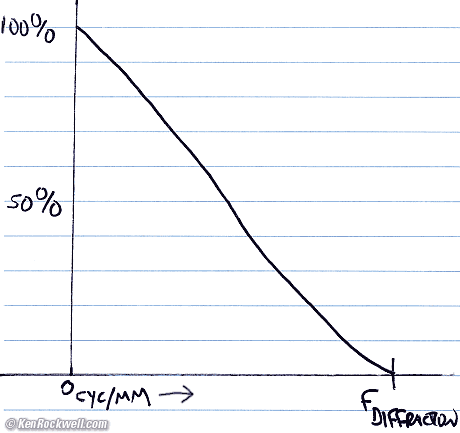Home Donate New Search Gallery How-To Books Links Workshops About Contact
Modulation Transfer Function (MTF)
(Modulationsuebertragung)
A lens' MTF curve.
This 100% all-content, junk-free website's biggest source of support is when you use those or any of these links to my personally approved sources I've used myself for way over 100 combined years when you get anything, regardless of the country in which you live. Camera boxes aren't sealed, so never buy at retail or any other source not on my personally approved list since you'll have no way of knowing if you're missing accessories, getting a defective, damaged, returned, non-USA, store demo or used camera — and all of my personally approved sources allow for 100% cash-back returns for at least 30 days if you don't love your new camera. I've used many of these sources since the 1970s because I can try it in my own hands and return it if I don't love it, and because they ship from secure remote warehouses where no one gets to touch your new camera before you do. Buy only from the approved sources I've used myself for decades for the best prices, service, return policies and selection.
February 2021 Better Pictures Canon Sony Nikon Fuji LEICA Zeiss Hasselblad All Reviews
WARNING: This article, like many of mine, deals with minor technical issues. These fine points are only significant after all the far more critical basics of location, composition, lighting, timing, color, tone and gesture have been mastered. Worrying about minute details like noise and resolution before you know how to make a good photo will ensure you never learn enough about the important issues to make great photos. If you'd like to learn how to make great photos, don't bother with these technical articles, instead read good books or take a local photo class. Your camera doesn't matter if you know what you're doing, and if you do know what you're doing, a better camera just makes it easier to get the results you demand.
INTRODUCTION back to top
MTF Lenses Film Digital Diffraction
MTF is way beyond the scope of this website and the majority of its users.
To understand MTF you need to be able to imagine mathematics in at least three or four dimensions at once. If you enjoyed getting your bachelor's degree in engineering, mathematics or physics as I did, this is easy, if not, I apologize since I'm not able to spend the time today to explain this in the simple terms in which I prefer to write.
Therefore I'll explain MTF in the simplest possible terms, and please forgive me because it won't be as clear or as complete as I prefer, and no, tetchiest, it won't be university-correct either. This is a simple article attempting to shed a little bit of light on a complex subject in the hope that it can illuminate some of my more mainstream articles.
I'm forgoing laboratory correctness in favor of making it clear to normal people.
MTF back to top
MTF Lenses Film Digital Diffraction
Modulation Transfer Function, MTF applies to every imaging system, film or digital.
We photographers see these in tech data sheets for film and sometimes for lenses.
It would be very helpful to have the plots for digital cameras, however most digital cameras today produce very messy plots due to aliasing and sharpening issues, so manufacturers are too embarrassed to share them.
MTF curves are plotted with the sharpness (Modulation) vertically, in percent, from 0 to 100%.
The Transfer Function we're measuring is plotted horizontally. The two completely different aspects we see plotted horizontally are either:
1.) The fineness of the detail, or modulating frequency, in cycles per millimeter (plotted usually for film), or,
2.) The distance away from the center of an image, usually plotted for lenses.
Cycles per millimeter is also called lines per millimeter.
Lenses back to top
MTF Lenses Film Digital Diffraction
Lens MTF. Fat lines: 10 cyc/mm, thin lines: 30 cyc/mm. Solid: Sagittal, dashed: Meridional.
Lens MTF curves are plotted at a specified level of detail expressed in cycles per millimeter. Most digital and 35mm lenses are plotted for 10 cyc/mm and also at 30 or 40 cyc/mm.
10 cyc/mm is a lower level of detail, and the most important one. When you look at an image, the most important spatial frequency usually is shown by the 10 cyc/mm line. That's why it's usually shown in bold..
30 or 40 cyc/mm is a very fine level of detail. It's nice to have detail here, but more important to have good response at 10 cyc/mm, which has more to do with contrast and the overall snap of an image.
The left side of the graph shows the performance at the center of the image. Since sharpness is usually best in the center, the graph starts at the top and slopes down as you go to the right.
The right side of the graph is the part of the image farthest from the center, what most people call the corners.
Extra credit: Lens MTF graphs plot sharpness for different angles, called sagittal and meridional, or radial, axial and tangential, or even more confusing terms. These terms differentiate between details running axially from the center of the image, or details running like circle around it. (Here's another one of those dimensions I mentioned at the top.) Better lenses will have these pairs of lines close to each other; if these lines get far apart, the image appears smeared because it means that lines running at one angle are sharper than those running at different angles. We see this most often in wide lenses at the corners.
Reality Check: Why MTFs Don't Matter
1.) Most MTF curves are merely plotted from calculations, meaning they are only true in the manufacturer's wildest dreams. No real lens from the assembly line would ever be able to equal this, since tolerances are never perfect. Real MTF curves are measured from real samples of lens.
2.) If the curves are simply plotted, do they include the effects of diffraction? In actual shooting diffraction can't be worked around, however some makers love to show calculated MTFs which ignore laws of physics like diffraction to yield better-looking fairy-tale MTFs.
3.) MTF curves look best when plotted for only one color, and worse if plotted for several colors integrated at once. They look worst for white light, which is how we actually use them taking pictures. A monochromatic (single-color) MTF curve conveniently ignores chromatic aberrations!
4.) MTFs can be plotted either for a flat plane, or the surface of best focus. All lenses have curvature of field. You can plot MTF for a flat plane which represents a real sensor but will make areas of that curve look worse because of the defocus introduced in some regions by the field curvature, or you can plot the curve for the best focus at every distance from the center, which makes lenses look much better than they are. I've tested some LEICA lenses that had magnificent advertised MTFs, but had heavy field curvature so in actual use the corners were very soft.
An MTF curve is meaningless unless the curve specifies if the results are measured or calculated (dreamed), for what color, colors or bands of light and with what mixing percentages, and at what focused distances (reproduction ratios), whether they are for flat image planes or surfaces of best focus.
Lens makers rarely specify which conditions they are using, meaning the graphs are meaningless, and are especially dangerous to use to compare between different brands. Of course they also need to specify aperture and focal length settings, which is all they usually do.
Schneider is the only lens maker of which I know who publishes meaningful MTF graphs. The graphs from Nikon, Canon and Sigma are offered without any meaningful specifications, so Heaven help you if yo make purchasing decisions by comparing them to each other.
5.) Even if you have legitimate MTF curves all measured (not calculated) under the same conditions so comparison might be meaningful (hint: it's usually OK to compare within the same brand, but never valid to compare MTFs between brands), MTFs are drawn with linear percent for the vertical scale. While the difference between 80% and 100% looks huge and is obvious when comparing curves, in actual shooting, this 20% difference in contrast isn't usually visible, much less significant. MTF curves are for Ph. D.s to see slight variations in performances as they're optimizing a design. MTF curves exaggerate minor or even invisible differences between otherwise identical-performing lenses. MTF curves let anyone plainly see subtleties that are invisible in actual photos.
6.) Even if you have a huge and visible differences between two similarly-measured MTFs, MTFs are usually only plotted at maximum aperture, where lens design is most difficult and lenses vary the most from each other. Lenses get better as stopped down, and at f/8 most are at their sharpest (they get softer at f/11 and smaller due to diffraction). This means that at normal taking apertures, even lenses that might be different wide-open will look pretty much the same!
That's right: under normal shooting at moderate apertures, pretty much every lens introduced since 2010 is just about optically flawless on today's highest-resolution cameras, and that also applies to good lenses going back many decades. The differences are only visible if you look in the far corners at maximum apertures, and only then if you actually have something in perfect focus in the corner, which is rare at maximum aperture.
Film back to top
MTF Lenses Film Digital Diffraction
Film MTF.
Film is simple.
Film MTFs simply plot the response versus frequency, exactly as analog audio equipment used to do.
Film MTF curves are reasonably believable. Film MTFs show 100% contrast at low frequencies, and this falls off as the detail gets finer.
Some films, like Velvia, add some sharpness at moderate resolutions, which looks great.
Digital back to top
MTF Lenses Film Digital Diffraction
Digital Camera MTF
One reason digital and video images look digital or like video is because their MTFs are messy.
Unlike lenses and film, electronic imaging does weird things with electronic filtration and processing which leads to abrupt changes in the MTF curve, which is unnatural. This leads to unnatural-looking details in the final image.
An image might look sharp due to a boosted or sharpened range of frequencies, but unnatural because electronic images, digital still or video, abruptly go to zero MTF at their native resolution. A digital camera's native (or more formally Nyquist unambiguous resolution) is one-half it's pixel pitch. The excess sharpening added to make up for the lost finer detail leads to harshness and halos.
A film MTF is a smooth curve. Finer details get softer, and that's about it. Some exceptional films like Velvia emphasize some details, but not that much, and the MTF curve never makes any abrupt changes.
The "dead cat bounce" at the end are aliases. These are the moirés and weird color patterns you sometimes see on fine repeating patterns on some digital cameras. These happen when a repeating detail repeats more often than there are pixels. This confuses the system into seeing something that's not there.
It can do this because some of the fat pixels may see more light or dark sections of the fine subject pattern, which then causes alternating pixels to show themselves as lighter or darker than the pixels next to them. When pixels do this, you see moiré patterns (aliases), since with details finer than the actual pixels, the pixels all ought to be the same matching color as the pixels next to them. When pixels start seeing details finer than themselves, this is called false resolution or aliases If you look at a resolution chart, many popular digital cameras show this by appearing to resolve the patterns, but careful observation shows that the lines on the image are less close together than they ought to be.
Good digital cameras use proper anti-aliasing filters in front of their sensors to eliminate any frequencies above the native system resolution. Poorer systems hope that you'll use crappy lenses, or not focus them accurately enough, to serve the same purpose.
If you use a good enough lens on a system with a weak anti-alias filter, like the Nikon D70 or the Leica M8, you can see these patterns on fabrics and screen windows. An advantage to systems with weak anti-alias filters is that they give genuinely sharper images, so long as there are no sharp details to excite aliases.
This is one of those topics about which I need to write another paper. If you're interested in more detail, this is called sampling theory. It's covered in every textbook on digital signal processing, both for analog one-dimensional signals and two-dimensional images.
Film versus Digital
Film vs. Digital. Roll your mouse over to see digital.
They are the same at low frequencies, which represents overall contrast.
Digital and video add a huge peak at medium levels of detail. In digital we call this sharpening, for which cameras usually have an adjustment, and in video we used to call it peaking and now aperture correction. This peak of sharpening makes the image look sharp and attempts to fool our eyes to make up for the complete lack of detail at the higher frequencies above the native resolution of the system.
Film, done properly with every step in the chain in prefect focus, has resolution even at the highest frequencies.
Digital adds sharpening at moderate frequencies to attempt to fool our eyes for the lack of details at the highest frequencies. This is why digital images and video can look as sharp, but unnaturally harsh, compared to film.
Diffraction back to top
MTF Lenses Film Digital Diffraction
Diffraction-Limited MTF. F(diffraction) = 1,800 / f/stop.
Diffraction limits every optical system's resolution.
Diffraction is worst at small f/numbers, like f/22, and not an issue at large f/numbers like f/4.
The resolution at which the graph falls to zero is calculated as 1,800 / f/stop. For instance, at f/18, it's at 100 cyc/mm (1,800 / 18 = 100) , and for f/1.8, it's 1,000 cyc/mm (1,800 / 1.8 = 1,000).
See more at my Diffraction page.
More Information: Carl Zeiss' paper on reading MTFs.
Help Me Help You
I support my growing family through this website, as crazy as it might seem.
The biggest help is when you use any of these links when you get anything. It costs you nothing, and is this site's, and thus my family's, biggest source of support. These places always have the best prices and service, which is why I've used them since before this website existed. I recommend them all personally.
If you find this page as helpful as a book you might have had to buy or a workshop you may have had to take, feel free to help me continue helping everyone.
If you've gotten your gear through one of my links or helped otherwise, you're family. It's great people like you who allow me to keep adding to this site full-time. Thanks!
If you haven't helped yet, please do, and consider helping me with a gift of $5.00.
As this page is copyrighted and formally registered, it is unlawful to make copies, especially in the form of printouts for personal use. If you wish to make a printout for personal use, you are granted one-time permission only if you PayPal me $5.00 per printout or part thereof. Thank you!
Thanks for reading!
Ken.




